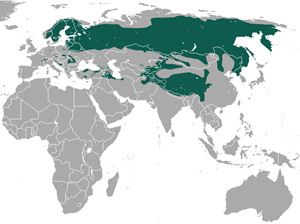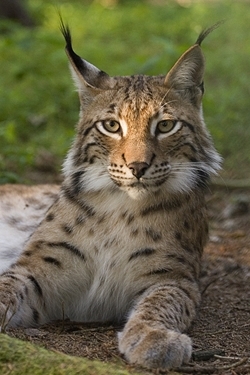Contents
Background
Q: Are lynx native to Britain?
 A: Based on archaeological evidence, the range of the Eurasian lynx (Lynx lynx) included Britain until at least 1,300 years ago. It is difficult to be precise about when or why lynx became extinct here, but it was almost certainly related to human activity – deforestation removed their preferred habitat, and also that of their prey, thus reducing prey availability. These declines in prey species may have been exacerbated by human hunting.
A: Based on archaeological evidence, the range of the Eurasian lynx (Lynx lynx) included Britain until at least 1,300 years ago. It is difficult to be precise about when or why lynx became extinct here, but it was almost certainly related to human activity – deforestation removed their preferred habitat, and also that of their prey, thus reducing prey availability. These declines in prey species may have been exacerbated by human hunting.
Q: Where do they live now?
A: Across Europe, Scandinavia, Russia, northern China and Southeast Asia. The range used to include other areas of Western Europe, including Britain, where they are no longer present.
Q: How many are there?
A: There are thought to be around 50,000 in the world, of which 9,000-10,000 live in Europe. They are considered to be a species of least concern by the IUCN.
Q: How big are they?
A: Lynx are on average around 1m in length, 75cm tall and around 20kg, with the males being slightly larger than the females. They can live to 15 years old, but this is rare in the wild.
Q: What do they eat?
A: The preferred prey of the lynx are the smaller deer species, primarily the roe deer. Lynx may also prey upon other deer species, including chamois, sika deer, smaller red deer, muntjac and fallow deer.
Q: Do they eat other things?
A: Yes. Lynx prey on many other species when their preferred prey is scarce, including rabbits, hares, foxes, wildcats, squirrel, pine marten, domestic pets, sheep, goats and reared gamebirds. The proportion of their diet made up of these alternative prey is generally very small.
Q: When do they hunt?
A: Lynx are generally nocturnal, with periods of hunting activity mirroring their prey’s behaviour, for example hunting deer at dawn and dusk. Because they are nocturnal, solitary and secretive animals, they are seldom witnessed by humans.
Q: What habitat do they need?
A: Lynx generally inhabit wooded areas, away from human disturbance. The woodland structure may be important, requiring diversity in the structure of the forest they select. They need cover available for stalking prey and dense thickets for resting, as well as an adequate supply of prey. However, in some areas, lynx are known to utilise more open, non-wooded semi-natural countryside.
Q: How large an area do they need?
A: The size of individual territories can vary widely in different regions, from 100km2 to 2,800km2 depending on differences in habitat and food availability.
Q: What are the main threats to lynx?
A: The main causes of mortality are illegal killing, accounting for 30-50%, as well as vehicle collisions and legal hunting.
Reintroduction
Q: Have they been reintroduced in other countries?
 A: There have been at least 15 attempted reintroductions in nine countries across Europe. These have resulted in several breeding populations, but none of them are yet considered to be independently viable.
A: There have been at least 15 attempted reintroductions in nine countries across Europe. These have resulted in several breeding populations, but none of them are yet considered to be independently viable.
Q: How successful are these reintroductions?
A: Of the breeding populations that have become established, the only one that is increasing in number is in the Jura mountains spanning the border of France and Switzerland.
Q: How has this been managed?
A: After an initial period with no monitoring or management, the lynx population grew and there were increased reports of impacts on livestock and conflict with landowners. Management was introduced to ease this situation, in the form of a translocation project to move some animals from western to eastern Switzerland.
Q: Is population management ongoing?
A: Since the translocations, monitoring has been ongoing. As a result, we now know these lynx populations are relatively small, and isolated from one another. This has resulted in inbreeding, leading to problems such as heart defects.
Q: What can be done about this?
A: Further population management may reduce this risk. Proposals include moving individuals between areas, or introducing new animals from the original source populations to increase genetic diversity.
Q: Is it always necessary to manage reintroduced populations?
A: Where humans make sudden changes such as a species removal or reintroduction, it is important that we bear responsibility for the consequences. For successful environmental interventions, careful planning and close monitoring are vital. We need to be ready to take an appropriate level of management where necessary. Without this planning and management, animal welfare problems and increased human-wildlife conflict appear to be common.
Q: How large do populations need to be to be independently viable?
A: The IUCN considers that a lynx population would need around 250 individuals to be likely to survive 100 years without intervention. This means having the capacity and genetic diversity to survive episodes of disease, adverse weather conditions or periods of prey scarcity. A population smaller than this is likely to need management to thrive.
Q: How large an area is required for such a population?
A: It is difficult to estimate, as territories vary so widely in size between regions. However, it would need very large areas of suitable habitat that are sufficiently connected for animals to travel between them and establish their territories relatively free of human disturbance. The only area with the potential to support a population of this type in the UK is the Highlands of Scotland.
Q: Might lynx be reintroduced in the UK?
A: It has been suggested that lynx reintroduction in the UK should be considered. There are many unknowns regarding the effects of such a reintroduction, including but not limited to the following:
- The suitability of UK habitat, including forest structure.
- The size of territories lynx might establish in the UK, therefore the area needed to support a healthy population.
- Whether lynx may utilise open habitat in the UK.
- Whether reintroduction would be appropriate when considering lynx welfare.
- Possible impact on livestock, as farming practices differ from other countries where lynx live, and how these could be mitigated.
- Possible impact on other species of conservation concern if they are predated in times when preferred food sources are scarce.
- Possible impact on deer populations, and therefore effect on population management or hunting opportunities.
- Possible impact on existing predator-prey relationships, for example by reducing fox populations in some areas.
Q: What do reintroduction processes involve?
A: The reintroduction of any species requires a multitude of steps:
- A licence must be sought, demonstrating proper public consultation, consideration of the health and welfare of the animals involved, evidence gathering, and thorough assessment of all potential impacts including biological and socio-economic effects.
- As a high-profile issue, extended consultation with and support of stakeholders would be an essential component of any application for lynx, particularly those who would be directly affected.
- Criteria for monitoring and success must be set, along with an appropriate exit strategy should it be required.
- The licence applicant should have a sufficient budget to bear the costs of the reintroduction until the scheme is judged a success, or to cover the exit strategy and any mitigation costs if necessary.